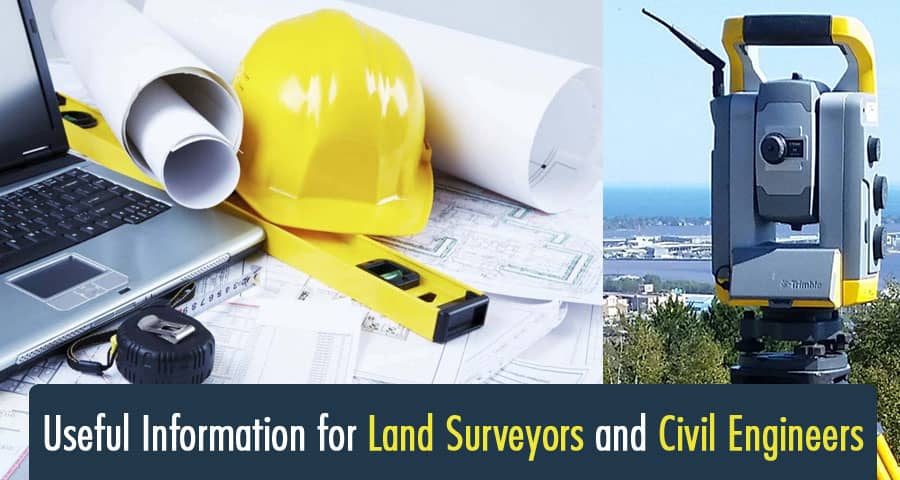Useful Information for Land Surveyors and Civil Engineers

Introduction
Land surveyors and civil engineers play vital roles in the design, planning, and development of infrastructure projects. To excel in their professions, they require a deep understanding of various concepts, techniques, and technologies.
Geodetic Surveying
Geodetic surveying involves the measurement and mapping of large areas, taking into account the Earth's curvature. Understanding geodetic principles, coordinate systems, and datum transformations is crucial for accurate positioning and mapping over vast territories.
Topographic Surveying
Topographic surveying focuses on gathering detailed information about the natural and man-made features of a specific area. It includes mapping contours, elevation data, vegetation, water bodies, structures, and other relevant features. Topographic surveys provide valuable data for site planning and design.
Land Boundary Surveying
Land boundary surveying aims to establish and retrace property boundaries. This involves researching historical records, analyzing legal descriptions, conducting field measurements, and resolving boundary disputes. Knowledge of land laws, deed interpretation, and surveying regulations is essential for accurate boundary determination.
Global Positioning System (GPS) Technology
GPS technology has revolutionized surveying and civil engineering. Understanding GPS principles, satellite constellation, differential correction techniques, and equipment operation is crucial for precise positioning, navigation, and data collection in the field.
Geographic Information System (GIS)
GIS integrates spatial data with attribute data, enabling land surveyors and civil engineers to analyze, visualize, and manage geographic information effectively. Proficiency in GIS software, data manipulation, geospatial analysis, and map production enhances decision-making and project planning.
Construction Surveying
Construction surveying involves staking out precise locations and alignments for construction projects. This includes establishing control points, verifying grades and elevations, monitoring construction progress, and ensuring adherence to design specifications. Knowledge of construction techniques, surveying instruments, and interpretation of construction plans is vital for accurate implementation.
Remote Sensing and LiDAR Technology
Remote sensing technologies, such as aerial photography and LiDAR (Light Detection and Ranging), provide valuable data for land surveyors and civil engineers. Familiarity with image interpretation, LiDAR data processing, and terrain modeling techniques enables efficient data extraction and analysis for various applications.
Structural Analysis and Design
Civil engineers must possess a strong foundation in structural analysis and design principles. This includes understanding structural behavior, load calculations, material properties, and design codes. Proficiency in structural analysis software and design methodologies ensures safe and efficient structural designs.
Environmental Considerations
Land surveyors and civil engineers need to consider environmental factors when planning and designing projects. This includes assessing potential impacts on ecosystems, water resources, air quality, and compliance with environmental regulations. Understanding environmental assessment methods and sustainable design practices promotes environmentally responsible projects.
Professional Ethics and Continuing Education
Maintaining high ethical standards is crucial for land surveyors and civil engineers. Upholding professional integrity, client confidentiality, and adherence to ethical codes fosters trust and credibility. Additionally, engaging in continuing education and staying updated with industry advancements is essential to enhance technical skills and stay informed about evolving practices and regulations.
Conclusion
Land surveyors and civil engineers can benefit from a diverse range of knowledge and skills. Understanding geodetic surveying, topographic surveying, land boundary surveying, GPS technology, GIS, construction surveying, remote sensing, structural analysis, environmental considerations, and professional ethics empowers professionals to deliver accurate, efficient, and sustainable solutions. By staying abreast of industry advancements and continuously expanding their expertise, land surveyors and civil engineers can excel in their roles and contribute to the development of infrastructure projects.
FAQs
What software is commonly used in GIS for land surveyors and civil engineers?
Common GIS software used by land surveyors and civil engineers include ArcGIS, QGIS, and AutoCAD Map 3D. These software packages provide powerful tools for data analysis, visualization, and map production.
How can land surveyors and civil engineers stay updated with industry advancements?
Land surveyors and civil engineers can stay updated by participating in professional organizations, attending conferences and seminars, reading industry publications, and engaging in online forums and discussions. Continuous learning and professional development opportunities help professionals stay current with new technologies, methodologies, and regulations.
What is the importance of professional ethics for land surveyors and civil engineers?
Professional ethics are crucial for maintaining the integrity of the profession and ensuring the delivery of quality services. Upholding ethical standards promotes trust, professionalism, and client satisfaction. It also contributes to the overall reputation and credibility of the land surveying and civil engineering professions.
What are some sustainable design practices in civil engineering?
Sustainable design practices in civil engineering include incorporating energy-efficient systems, using environmentally friendly materials, reducing waste generation, implementing stormwater management strategies, and promoting green infrastructure. These practices aim to minimize environmental impact and promote long-term sustainability in infrastructure development.
How can land surveyors and civil engineers contribute to environmental protection?
Land surveyors and civil engineers can contribute to environmental protection by integrating environmental considerations into project planning, implementing sustainable design practices, minimizing disturbance to natural habitats, and ensuring compliance with environmental regulations. They can also promote the use of eco-friendly technologies and materials in construction projects.
